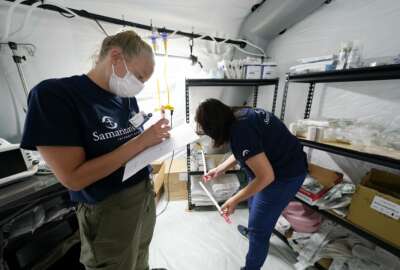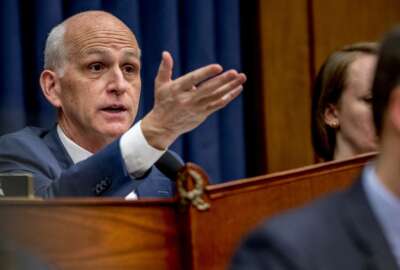
Defense Department looks to buy more monoclonal antibodies
In today's Federal Newscast, a major contract from the Pentagon to purchase more doses of one of the only proven treatments of COVID-19.
To listen to the Federal Newscast on your phone or mobile device, subscribe in PodcastOne or Apple Podcasts. The best listening experience on desktop can be found using Chrome, Firefox or Safari.
- Commercial services should be first on the list of capabilities intel analysts look to leverage for geospatial intelligence. That’s according to a forthcoming strategy from the National Geospatial-Intelligence Agency. NGA wants analysts to think about new services available in the private sector before they turn to traditional, in-demand government satellites. The new strategy is part of a broader push in the intelligence community to increasingly turn to the rapidly evolving commercial space sector for capabilities. (Federal News Network)
- A vendor on the Postal Service’s shortlist for a delivery vehicle contract ends its bid protest over the award. The electric vehicle company Workhorse Group is withdrawing its bid protest over USPS’s award to Oshkosh Defense. Workhorse withdrew its complaint the day before oral arguments were scheduled before the U.S. Court of Federal Claims. The vendor argued its prototype was unfairly taken out of consideration over an accident caused by a USPS driver. But attorneys for USPS and the Justice Department said Workhorse didn’t exhaust its administrative appeal options before filing the bid protest. (Federal News Network)
- There are only seven days left to submit ideas or vote on others’ ideas for how to improve federal procurement. The Office of Federal Procurement Policy’s online forum, called EPIC, will close out this round of feedback on September 22. Currently, OFPP Innovates is accepting ideas around seven concepts, including stewardship of federal procurement, improving the agility and streamlining acquisition using data and technology and modernizing the acquisition workforce. So far, OFPP Innovates have received more than 100 ideas since it launched this effort in April.
- Agencies get some help in tackling one of the biggest challenges with implementing the Technology Business Management Framework. As agencies move forward in using the Technology Business Management Framework by the end of fiscal 2022 to manage their technology costs, one area that needed some clarity is around the cost of the IT workforce. The CIO Council’s Federal IT Management Community of Practice is trying to solve that challenge by cross walking the National Initiative for Cybersecurity Education (NICE) framework with TBM. The community of practice said by using the NICE framework, agencies can identify the IT labor workforce inside and outside of the CIO’s office, provide business rules for calculating IT specific labor costs from total labor costs and automate the allocation of the IT internal labor to IT towers and resources.
- Lawmakers are looking to set up a new cybersecurity apprenticeship program to address the cyber talent shortfall. The Cybersecurity and Infrastructure Security Agency would take on apprentices under a bipartisan amendment submitted for the House defense authorization bill. The idea is to create new pathways for cybersecurity service in the federal government, which is competing with the private sector for scarce digital talent. The amendment would also create a cybersecurity training pilot program at the Department of Veterans Affairs for veterans and members of the armed forces transitioning from service to civilian life. The House is expected to debate the defense bill next week.
- The Air Force Research Laboratory is beginning construction on a more than ten thousand square foot facility to advance wargaming and simulation for its directed energy and space vehicles directorates. The $6 million lab will include an auditorium with more than 90 workstations for advanced concept experiments that will allow collaboration across the military. The building will be located on Kirtland Air Force Base in New Mexico.
- The Army is taking further steps to give more civilian oversight to sexual assault cases in the military. The branch established it’s own civilian office to decide if the military should take legal action on sexual assault or harassment incidents. Each of the military branches are expected to create similar offices in the near future. The change takes power away from individual commanders who previously decided if legal action should take place. The policy stems from an independent review on sexual assault in the military, which found that commanders were not always taking the proper steps to charge individuals accused of sex crimes.
- A large contract from the Pentagon to purchase more doses of one of the only proven treatments of COVID-19. The Defense Department is awarding two contract modifications worth $3.2 billion to purchase additional doses of monoclonal antibodies. The biggest of the two is going to Regeneron Pharmaceuticals, the other to Eli Lilly and Company.
- 72% of Veterans Health Administration employees subject to the VA mandate are vaccinated. VHA employees have until October 8 to either get vaccinated or request a medical or religious exception. Then the disciplinary process will kick in. VA Secretary Denis McDonough said “That will be a very clear process implemented at the supervisor and local level, the goal of which is to get people vaccinated…the provision of education and so forth. But if at the end of that progressive discipline they’ve still chosen to not get vaccinated or get an exemption, they will be separated from federal service.” (Federal News Network)
- The Department of Veterans Affairs is referring a record number of veterans to the community for health care. It sent an average of 550,000 veterans a month to community providers between March and August. And it’s spending about $2 billion a month on those services. That’s well above the monthly average over the last three years, and well above the historic average before the MISSION Act set specific community care access standards. 1.2 million veterans visited a community care provider in 2014. At least 2.2 million veterans got a community care referral from VA so far this year. (Federal News Network)
- More than a quarter of the State Department’s buildings overseas are in poor condition, according to the department’s own standards. The Government Accountability Office finds more than 400 buildings in poor conditions are facilities that the department considers mission-critical. State is spending about $500 million a year on maintenance, but the square footage of its real estate grew by more than more than 10% between 2015 and 2019.
- Now it’s easier to find government publications going back to the second Grover Cleveland administration. For the curious historically, the Government Publishing Office has digitized and put online the Monthly Catalog of U.S. Government Publications. It lists pretty much everything the government printed between 1985 and 2004. Visitors can find titles, authors, and dates of publications. Highlights include World War II rationing posters and old State Department diplomatic lists. It’s one of several indexes GPO has digitized, some dating to late colonial times.
Copyright © 2025 Federal News Network. All rights reserved. This website is not intended for users located within the European Economic Area.
Eric White
Eric White is news anchor and Federal Drive producer at Federal News Network.
Follow @FEDERALNEWSCAST





